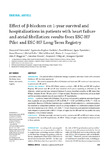Mostrar o rexistro simple do ítem
Effect of β-blockers on 1-year survival and hospitalizations in patients with heart failure and atrial fibrillation: results from ESC-HF pilot and ESC-HF long-term registry
| dc.contributor.author | Ozieranski, Krzysztof | |
| dc.contributor.author | Kaplon-Cieslicka, Agnieszka | |
| dc.contributor.author | Balsam, Pawel | |
| dc.contributor.author | Tyminska, Agata | |
| dc.contributor.author | Wancerz, Anna | |
| dc.contributor.author | Peller, Michal | |
| dc.contributor.author | Marchel, Michal | |
| dc.contributor.author | Crespo-Leiro, María Generosa | |
| dc.contributor.author | Maggioni, Aldo P. | |
| dc.contributor.author | Drozdz, Jaroslaw | |
| dc.contributor.author | Filipiak, Krzysztof J. | |
| dc.contributor.author | Opolski, Grzegorz | |
| dc.date.accessioned | 2018-12-17T11:32:09Z | |
| dc.date.available | 2018-12-17T11:32:09Z | |
| dc.date.issued | 2018-10-10 | |
| dc.identifier.citation | Ozieranski K, Kaplon-Cieslicka A, Blasam P, et al. Effect of β-blockers on 1-year survival and hospitalizations in patients with heart failure and atrial fibrillation: results from ESC-HF pilot and ESC-HF long-term registry. Pol Arch Intern Med. 2018; 128(11): 649-657 | es_ES |
| dc.identifier.issn | 0032-3772 | |
| dc.identifier.uri | http://hdl.handle.net/2183/21524 | |
| dc.description.abstract | [Abstract] Introduction The positive effect of β-blocker therapy in patients with heart failure (HF) and atrial fibrillation (AF) has been questioned. Objectives We aimed to assess the effect of β-blockers and heart rate (HR) control on 1-year outcomes in patients with HF and AF. Patients and methods Of the 2019 Polish patients enrolled in ESC-HF Pilot and ESC-HF Long-Term Registry, 797 patients with HF and AF were classified into 2 groups depending on β-blocker use. Additionally, patient survival was compared between 3 groups classified according to HR: lower than 80 bpm, between 80 and 109 bpm, and of 110 bpm or higher. The primary endpoint was all-cause death and the secondary endpoint was all-cause death or HF hospitalization. Results In patients treated with β-blockers, the primary and secondary endpoints were less frequent than in patients not using β-blockers (10.9% vs 25.6%, P = 0.001 and 30.6% vs 44.2%, P = 0.02, respectively). Absence of β-blocker treatment was a predictor of both endpoints in a univariate analysis but remained an independent predictor only of the primary endpoint in a multivariate analysis (hazard ratio for β-blocker use, 0.52; 95% CI, 0.31–0.89; P = 0.02). The primary and secondary endpoints were more frequent in patients with a HR of 110 bpm or higher, but the HR itself did not predict the study endpoints in the univariate analysis. Conclusions β-blocker use might decrease mortality in patients with HF and AF, but it seems to have no impact on the risk of HF hospitalization. An HR of 110 bpm or higher may be related to worse survival in these patients. | es_ES |
| dc.language.iso | eng | es_ES |
| dc.publisher | Medycyna Praktyczna | es_ES |
| dc.relation.uri | http://dx.doi.org/10.20452/pamw.4346 | es_ES |
| dc.rights | Atribución-NoComercial-CompartirIgual 3.0 España | es_ES |
| dc.rights.uri | http://creativecommons.org/licenses/by-nc-sa/3.0/es/ | * |
| dc.subject | β-blockers | es_ES |
| dc.subject | Atrial fibrillation | es_ES |
| dc.subject | Heart failure | es_ES |
| dc.subject | Rate control | es_ES |
| dc.subject | Registry | es_ES |
| dc.title | Effect of β-blockers on 1-year survival and hospitalizations in patients with heart failure and atrial fibrillation: results from ESC-HF pilot and ESC-HF long-term registry | es_ES |
| dc.type | info:eu-repo/semantics/article | es_ES |
| dc.rights.access | info:eu-repo/semantics/openAccess | es_ES |
| UDC.journalTitle | Polish Archives of Internal Medicine | es_ES |
| UDC.volume | 128 | es_ES |
| UDC.issue | 11 | es_ES |
| UDC.startPage | 649 | es_ES |
| UDC.endPage | 657 | es_ES |
Ficheiros no ítem
Este ítem aparece na(s) seguinte(s) colección(s)
-
INIBIC-ICATC - Artigos [174]






